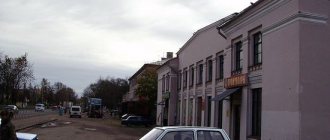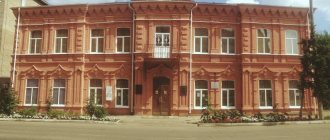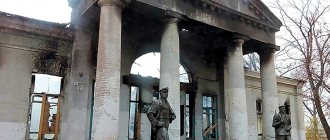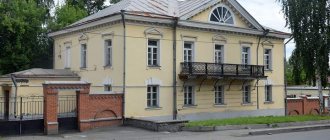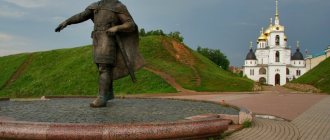Staraya Ladoga is referred to as the first capital of Rus' and is one of the oldest settlements in Russia.
Staraya Ladoga is located 150 km from St. Petersburg in the Leningrad region on the banks of the Volkhov River. Today, in terms of the number of ancient architecture of the 9th-19th centuries, it surpasses many Russian cities. Also here you can admire not only the architecture, but also enjoy the wonderful beauty of the landscapes and feel the spirit of antiquity. Now it is a village of 2000 people, but previously this place was the most important trading point.
If you drive 15 km up the river, you will see Novaya Ladoga, a town with a population of 9,000 people, which was founded in 1704 by Peter the Great to support the life of a shipyard and organize food delivery during the Second World War.
See prices for hotels in Ladoga on Booking.com=>>
Staraya Ladoga Fortress
One of the main attractions of Staraya Ladoga is the Staraya Ladoga Fortress, which was founded at the end of the 9th century.
The fortress was originally built from wood, but this seemed ineffective and so the fortress was rebuilt from stone for greater hardness. It was very important because it protected the entire waterway. Today it houses a museum that houses many different exhibits.
My impressions of Novaya Ladoga
Novaya Ladoga made an ambivalent impression on me. On the one hand, there is a beautifully planned city, a wide main street, the majestic Volkhov, canals, and the vast Lake Ladoga. But many buildings are dilapidated and require repairs. I think if it gets cleaned up it will become a popular tourist spot.
Wooden house in Novaya Ladoga
Entrance in a wooden house
Volkhov in Novaya Ladoga
Ships on the Volkhov in Novaya Ladoga
Mouth of the Volkhov
Ships near Volkhov
Arrow at the mouth of the Volkhov
Volkhov
Wooden house in Novaya Ladoga
Houses in Ladoga region
© Website “On the Roads of the Middle Way”, 2009-2021. Copying and reprinting of any materials and photographs from the site anashina.com in electronic publications and printed publications is prohibited.
Caves
See prices for hotels in Ladoga on Booking.com=>>
Staraya Ladoga is famous not only for its Architecture; there is something else, but no less interesting. These are caves. In old Ladoga there are as many as 2 dungeons. As is right, tourists who come to Staraya Ladoga always specially visit this place. These dungeons were created artificially. White sandstone was mined here, which was later used for glass production. Then the caves began to be used to study fossilized animals. There is one amazing place here, in one of the places at the farthest point of the cave the temperature is always 6 degrees Celsius. One of the dungeons has an underground lake with a depth of 0.5 meters, which never dries up.
Attention. To avoid getting lost, visit the cave only with experienced guides.
Church of Clement of Rome and Peter of Alexandria
Address: Karl Marx, 41
In the 18th century, a one-domed church was erected; in the 19th century, under the leadership of architect K. Fortunatov, a bell tower with a spire was added, which significantly changed the appearance of the temple. The church was closed in the early thirties. Now it is empty.
Nikolo-Medvedsky Monastery
In Novaya Ladoga, there are also many attractions that are worth visiting. One of them is the Nikolo-Medvedsky Monastery. It was founded in the 15th century and in 1583 was dilapidated at the hands of German knights. At the height of the Northern War in 1702, by order of Peter 1, the monastery was surrounded by an earthen rampart and ditches for protection purposes. Currently, only part of the remains have been preserved.
History of Novaya Ladoga
New Ladoga did not arise out of nowhere. , the Nikolo-Medvedsky (Nikolo-Medvedovsky) monastery was founded on the Medvedets Peninsula . It became a kind of border fortress; its defenders more than once repelled attacks from foreigners.
The snow-white spire of the bell tower of the Nikolo-Medvedsky Monastery is visible from afar. An earthen rampart with the remains of a ditch, the Church of St. John the Evangelist with the chapel of the Nativity of the Virgin Mary and a bell tower from the mid-18th century, and St. Nicholas Cathedral have been preserved.
Bell tower of the Nikolo-Medvedsky Monastery
In 1702, a shipyard was founded at the mouth of the Volkhov, where more than 2 thousand shipwrights were brought from the North.
Ships on Volkhov
After the founding of Novaya Ladoga in 1704, many residents of Ladoga moved here by order of the tsar, which from now on became known as Staraya Ladoga and lost its status as a city. Several infantry regiments were also stationed here. In 1727, Novoladozhsky district was founded, which was first part of the Novgorod province of the Novgorod province, and from 1781 - into the St. Petersburg province.
In 1719, construction of the Petrovsky Canal . In 1861-1866, parallel to it, almost along the shore of Lake Ladoga, a new canal was dug, with a total length of 110 km, and the old one received the prefix “old”. Currently, it is almost completely overgrown and dry; open areas remain only in Shlisselburg and Novaya Ladoga.
Novoladozhsky Canal
Novaya Ladoga is also associated with the name of Generalissimo A.V. Suvorov, who in 1763-69 commanded the Suzdal Infantry Regiment here and wrote “The Regimental Institution” - a theory of the education and training of soldiers.
Novaya Ladoga became an important strategic point during the Great Patriotic War. The Red Banner Ladoga Military Flotilla was based here , which ensured the functioning of the Road of Life - the only connection with besieged Leningrad. A huge boat on the shore, minesweeper No. 100, turned into a monument, reminds of those events. Alas, the local “craftsmen” did not spare him.
Recommendations
Notes
- ^ a b c d f f
Region Law No. 32-ounce - ^ a b c d Encyclopedia of Russian Cities
. Moscow: Great Russian Encyclopedia. 2003. p. 303. ISBN 5-7107-7399-9. - ^ a b
Federal State Statistics Service of Russia (2011).
“All-Russian Population Census 2010. Volume 1" [All-Russian Population Census 2010, vol. 1]. All-Russian Population Census 2010 [All-Russian Population Census 2010]
(in Russian). Federal State Statistics Service. - "26. The size of the permanent population of the Russian Federation by municipalities as of January 1, 2022.” Federal State Statistics Service. Retrieved January 23, 2022.
- ^ a b c d
Law No. 56-oz. - "On the calculation of time." Official Internet portal of legal information
(in Russian). June 3, 2011. Retrieved January 19, 2022. - Post office. Information and computing center of OASU RPO. ( Post office
).
Search for postal facilities ( Search for postal facilities
) (in Russian) - Federal State Statistics Service of Russia (May 21, 2004). “The population of Russia, the constituent entities of the Russian Federation as part of federal districts, urban settlements, urban settlements, settlements, settlements of 3 thousand or more people.” [Population of Russia, its federal districts, federal subjects, districts, urban settlements, rural settlements - administrative centers, rural settlements with a population of more than 3000 people] (XLS). All-Russian Population Census of 2002 [All-Russian Population Census of 2002]
(in Russian). - “All-Union Population Census of 1989. The actual population of the union and autonomous republics, autonomous regions and districts, territories, regions, urban settlements and villages. Culture of the Leningrad region.” Retrieved March 18, 2014.
- ^ a b c d
“Archival copy” Novoladozhsky district (1917 - February 1923), Volkhovsky district (February 1923 - August 1927) (in Russian). System of classifiers of executive bodies of state power of St. Petersburg. Archived from the original on February 22, 2014. Retrieved March 18, 2014.CS1 maint: archived copy as title (site link) - ^ a b c d f
“Archival copy” Volkhov district (August 1927) (in Russian). System of classifiers of executive bodies of state power of St. Petersburg. Archived from the original on March 17, 2014. Retrieved March 18, 2014.CS1 maint: archived copy as title (site link) - Monuments of history and culture of the peoples of the Russian Federation (in Russian). Ministry of Culture of Russia. Retrieved June 2, 2016.
The most ancient Ladoga in the Leningrad region
Few people know that Ladoga is the oldest city that has survived to this day in northern Russia. It was founded no later, and possibly earlier, in the mid-8th century. The city of Ladoga was an important point on the trade route “from the Varangians to the Greeks.”
When Tsar Peter I founded New Ladoga at the mouth of the Volkhov in 1704, he renamed Ladoga “Old Ladoga”. Since then, the latter has lost its city status and its coat of arms. And Novaya Ladoga is a city to this day.
Former barracks of the Suzdal regiment
In the period from 1764 to 1768, the legendary commander Alexander Vasilyevich Suvorov lived in Novaya Ladoga, then still a colonel appointed commander of the Suzdal infantry regiment, which at the end of the Seven Years' War was stationed here.
Agree, for a tiny town such a fact is an important page in its history. One of the reminders of the stay of such an honored guest in Novaya Ladoga is the barracks building where the soldiers were quartered.
Surprisingly, this building, located on the embankment of the Staraya Ladoga Canal, is still used as a residential building to this day. An ordinary two-story brick house, which has not seen renovation for several decades... And only the memorial plaque on the facade of the building reminds that once upon a time brave soldiers of the Suzdal Infantry walked along these stairs and corridors.
Address: St. Proletarsky Kan., 12, Novaya Ladoga, Leningrad region, Russia.
Officers' meeting building
Another house that both the officers of the Suzdal Infantry Regiment and Suvorov himself remember well is the building of the officers' meeting, in which, as you might guess, the regimental officers lived.
Unfortunately, this one-story wooden building, heavily damaged by a fire in the early 2000s, was in very poor condition for a long time, no one needed and forgotten by everyone. A leaky roof overgrown with moss, gaping holes in the windows, asocial elements as regular guests... - it was difficult to imagine that in the 18th century the flower of the Russian army spent time here.
A couple of years ago, the authorities finally remembered this building with a rich history and renovated it. Since the fall of 2022, it belongs to a new museum - the A.V. Suvorov Museum - which essentially existed for a long time, but never had its own permanent premises. And this is wonderful, because the museum is actually excellent, and it undoubtedly deserves both such “living space” and your attention.
Address: House of Officers' Assembly of the Suzdal Regiment, Suvorova Street, Novaya Ladoga, Leningrad Region, Russia.
Museum of Local Lore
The Novoladoga Museum of History and Local Lore opened its doors to visitors only in 1987, although the first attempts to create it were made before the war. But by the time the museum opened, an impressive collection had already been formed, and not without the participation of city residents, who donated personal items of value to the fund.
One of the most visited halls of the museum is dedicated to the famous Russian commander Alexander Vasilyevich Suvorov, who commanded the Suzdal Infantry Regiment, which was once based in Novaya Ladoga.
Of no less interest to visitors are the “Merchant Hall”, in which fragments of a merchant’s house are recreated, the “Ethnographic Hall”, where household items of the peoples of the Southern Ladoga region are presented, and the exhibition “Road of Life”, which tells about the role of the city in supporting neighboring Leningrad, 872 days of the former cut off from the “mainland” by enemy troops.
No less interesting is the building itself, which houses the museum - a two-story mansion built in the 1880s, which once belonged to the local merchant Timofeev. Alas, this architectural monument today is in disrepair, and therefore the museum is closed to visitors. We can only hope that the repairs will not take many years.
Address: Novoladoga Museum of History and Local Lore, Pionerskaya street, Novaya Ladoga, Leningrad region, Russia.
St. George's Church (Suvorov Church)
Few of the residents of Novaya Ladoga know that the church, located not far from the House of Officers’ Assembly, was consecrated in the name of St. George the Victorious, because people often call it “Suvorovskaya”. And this is no coincidence. This temple was built on the initiative and with the direct participation of Alexander Vasilyevich himself during his New Ladoga period of service and for a long time served as a regimental church.
With the advent of Soviet power, the church was closed and, as it turned out, forever. For several decades, the building was used as either a warehouse or a workshop, but this, as it turned out, was not the worst.
After a fire in 1988, only part of the semi-charred stone skeleton remained of the former temple. This landmark of Novaya Ladoga remains in this condition to this day. There are no funds for restoration, and Suvorov’s brainchild continues to slowly die.
Address: St. George Church, Suvorova street, Novaya Ladoga, Leningrad region, Russia.
Gostiny Dvor
The favorable geographical position of Novaya Ladoga for many decades predetermined the main activity of its residents - until 1917 it was a merchant city. Of course, there was also its own “Gostiny Dvor”, built in the 19th century and which was a smaller copy of the “big brother” located in St. Petersburg.
However, why was it - the building has survived to this day. Moreover, even today it does not change its historical purpose: here you will find a city market and small trading shops selling all kinds of goods, including local handicrafts and souvenirs.
Address: Novaya Ladoga, Karl Marx Ave., 25-27.
Monument to the Ladoga Military Flotilla
During the Great Patriotic War, Novaya Ladoga became the location of the headquarters of the Ladoga military flotilla, supporting the viability of besieged Leningrad by ensuring the safety of the “Road of Life” water route.
In memory of the feat of the sailors of the Ladoga flotilla, who at the cost of their lives provided transport links between besieged Leningrad and the country, a memorial complex was erected in Novaya Ladoga in 1982. It consists of two small vessels - the tugboat "Kharkov" and the minesweeper "TShch-100", which 80 years ago performed their military duty in the waters of Lake Ladoga.
Visitors to the memorial complex are not limited in their access to veteran ships: they can stand on the deck, climb onto the captain’s bridge, go down into the hold, or take a photo in front of an anti-aircraft gun... Naturally, this monument is very popular among boys.
Address: Monument to the Ladoga Military Flotilla and the memorial complex “Road of Life”, embankment of the Ladoga Flotilla, Novaya Ladoga, Leningrad region, Russia.


